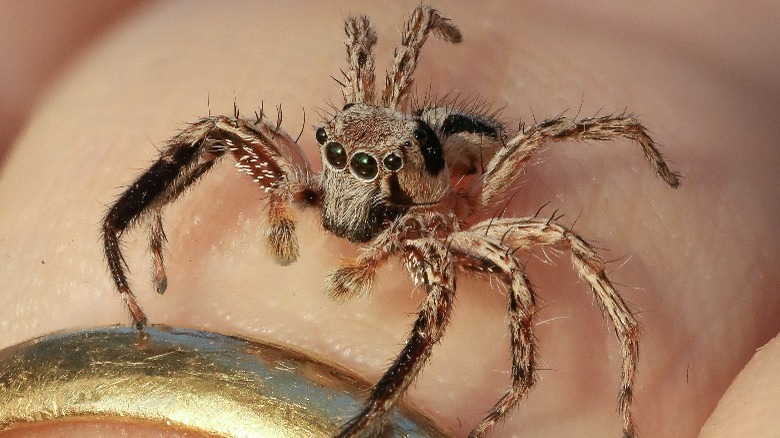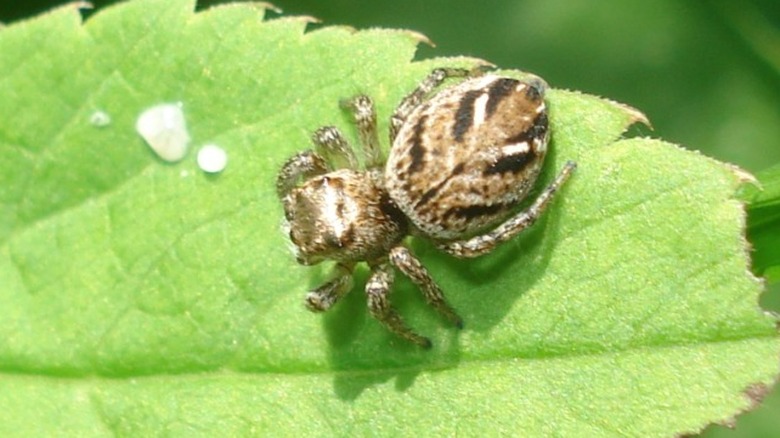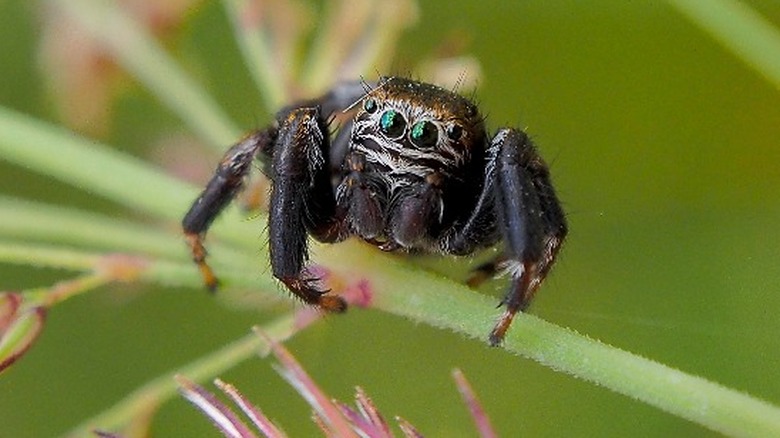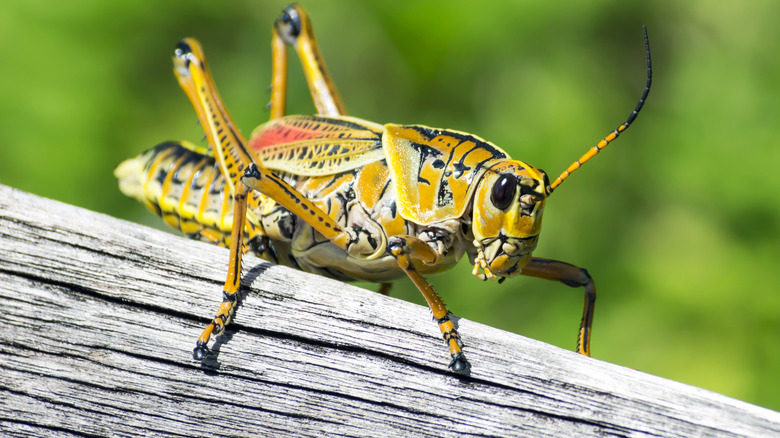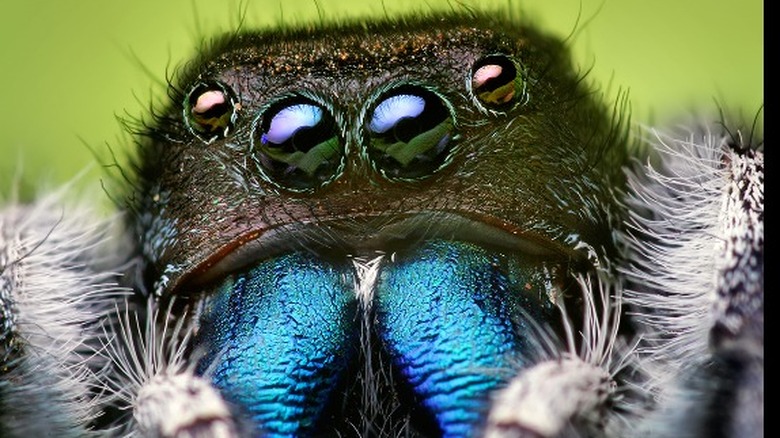One Accidental Discovery May Have Linked Humans And Spiders In An Unexpected Way
For many humans, spiders are the stuff of nightmares. But it turns out that these often misunderstood arachnids may have a more positive association with human sleep than we thought. A study published in the Proceedings of the National Academy of Sciences in August 2022 presented evidence that a certain species of spider may experience rapid eye movement, or REM, sleep.
REM sleep gets its name from the fact that, during this sleep stage, the sleeper's eye muscles move around without actually sending visual information to the brain (per WebMD). The University of Wisconsin at La Crosse entomologist and sleep biologist Barrett Klein told The Washington Post that he calls it "paradox" sleep because the body is near paralyzed, but the brain is extremely active. And scientists still aren't sure why it happens. "Memory consolidation and a type of learning seems to be specifically benefited by REM sleep," Klein said. Further, experts aren't sure how or why REM sleep evolved, according to the study. That's partly because there still hasn't been enough research into REM sleep in a wide selection of animals beyond land mammals and birds, which is what makes the new study so exciting. It's likely the first time that REM-like sleep patterns have been documented not just in spiders but in any land-based invertebrate, according to The Harvard Gazette. That's very far removed from humans and other mammals on the evolutionary tree, which presents a chance to learn more about REM's development, the study authors said.
Jumping in their sleep
The study focused on a certain species of spider called the jumping spider, scientific name Evarcha arcuate, family Salticidae. Jumping spiders have been described as "some of the most adorable arachnids," according to The Washington Post. They have large eyes, bright bodies, furry legs, and are sometimes so small they can stand on a fingertip (via NPR). Those big eyes are helpful for getting around one of the challenges of studying REM sleep in a diverse array of animal classes, the study explained: many have not evolved movable eyes. However, jumping spiders do have a movable retina, and those movements are visible in baby spiders because their exoskeletons are still translucent.
That said, the researchers did not set out to look for REM in jumping spiders. Behavioral ecologist Daniela C. Roessler of the University of Konstanz in Germany had a different experiment in mind when she caught some spiders and brought them home with her so that she could still do science while her lab was closed during the coronavirus lockdown. She told Scientific American that she wanted to see how the spiders would react to 3D-printed models of predatory spiders, but the spiders surprised her. She came home one day to find them hanging upside down from the clear, plastic boxes she had housed them in. "I had no idea what happened," Roessler said. "I thought they were dead."
Sleep studies
Luckily for the spiders, Daniela C. Roessler, and for science, the spiders weren't dead, merely asleep (via Scientific American). This was already a discovery. Previously, scientists thought that this species of jumping spider slept by building little silk sleeping bags in dead leaves, but Roessler's evidence showed they could also nap by imitating bats. To learn more about the spiders' sleeping habits, Roessler decided to film one overnight, and the footage led to another breakthrough. For repeated intervals of a little more than a minute each night, the spider would exhibit unusual behavior. "All the legs would curl into the body, and they would twitch while doing that," Roessler told NPR. In other words, it looked like the spider was in the midst of REM sleep. "These twitches seemed so classical, and they immediately reminded me of a dog dreaming," Roessler told The Washington Post.
To test this further, Roessler and her research team filmed 34 young spiders, all of which had eye movements that were still visible through their exoskeletons, according to the study. They saw that the spiders' retinas moved when their legs curled 100 percent of the time. "The combination of periodic limb twitches and eye movements during this sleep-like state as well as the increase of duration of REM sleep–like bouts meets core behavioral criteria of REM sleep observed in vertebrates, including humans," the study authors concluded.
Do spiders dream?
Is it possible that the spiders are actually dreaming? More research would need to be done to find out, and even then, confirming it would be a challenge, according to The Harvard Gazette. However, Daniela C. Roessler's gut instinct? "I personally think they are dreaming," she said. University of Florida behavioral ecologist Lisa Taylor, who was not part of the study but also works with jumping spiders, told Scientific American that she also thought they could dream. "They live in such a rich sensory world, and we know they have amazing cognitive capabilities and memory," she said.
If the spiders do dream, that doesn't mean their dreams would be like ours. For humans, dreaming is typically a visual experience, like watching a movie, but Roessler told The Washington Post that it's possible the spiders would dream in vibrations. Since jumping spiders are a very visual species, it is possible that they do dream up their own little spider movies. Other spider species rely less on their eyes, though they have otherwise similar brains, study co-author Paul Shamble — a former John Harvard Distinguished Science Fellow — told The Harvard Gazette. "It makes me wonder if dreaming happens in a lot of different ways," he said. As far as the content of the dreams goes, Shamble thought it could be more like that of human dreams. "I assume that they're dreaming about their own lives, like what happens to them during the day," he said.
Next steps
Before the scientists can determine whether or not spiders dream, though, they first have to confirm that they are actually asleep. To do so, the scientists need to prove two things, according to Scientific American. First, they need to demonstrate that the spiders are not as aware of their environment while they are in the REM-like twitching state. Then, they need to prove that the spiders' brains are actually active during these periods of physical movement. This can be achieved by inserting an electrode into the spiders' brains, something another research team has achieved with a different jumping spider species.
Testing whether or not the spiders are dreaming while asleep will be more difficult but not impossible. One idea floated by Daniela C.Roessler is to play baby spiders a video of something they might encounter during their day, like a cricket jumping, and then measure their eye movements. If they repeat the same eye movements during the night, then that would be a sign they are dreaming of tracking a tasty snack.
The I in spider
Whatever the results of further testing, the research has opened up fascinating questions about the purpose of sleep and dreams across the animal kingdom. "[T]hat possibility makes you wonder what dreaming is for and what it's doing. Because the brains of these animals are so different from ours and their evolutionary history is so different from ours," Paul Shamble told The Harvard Gazette. He suggested that dreaming might be an activity generated by all brains that process information visually, something that scientists had not considered before. And if it turns out that less-visual spiders also enter REM sleep, something that Daniela C. Roessler wants to test, it could mean that REM sleep is something shared by all or most animals, according to Scientific American.
Finally, the research raises the question of spider consciousness. San Francisco State University philosopher David Peña-Guzmán, who was not involved with the research, told Scientific American that a spider that dreams implies the spider has some concept of "I" to dream as. "It might mean that we start talking about spiders having something like a minimal self," he said. So the next time you wake up sweating after a nightmare about spiders, perhaps lull yourself to sleep with the idea that the spider could be twitching through a nightmare of you, brandishing a fly swatter.

